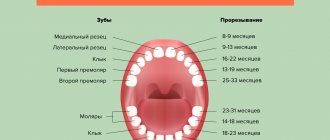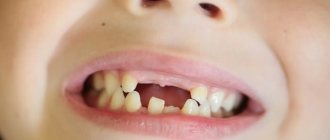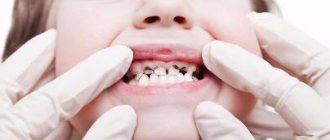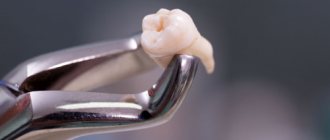What are the features of the eruption of “temporary” teeth?
Baby teething normally occurs at six months of age. The first sign of this process is the formation of a dental tubercle on the edge of the gum. This occurs as a result of pressure on the mucous membrane - it gradually stretches, becomes thinner and a breakthrough occurs. Then you can see the edge of the crown of the new tooth above the gum. As soon as the entire crown appears above the gum cavity, this is the eruption of the tooth.
In various sources you can find exact dates for teething, but they are arbitrary. Any discrepancies with them depend on the individual developmental characteristics of the baby. There is no need to worry if your child's first tooth appears later or earlier than his peers. Teething is a natural process that occurs on an individual schedule.
Did you know that baby teeth have roots? It’s just that by the time they begin to fall out, they resolve on their own. If sometimes a tooth has to be removed before its natural loss occurs, its root can be seen.
In erupted baby teeth, the formation of roots occurs according to the following scheme:
- The formation of the roots of the incisors occurs by the age of two.
- The roots of the molars will be fully formed by the age of 4 years.
- The formation of the roots of the fangs occurs by the age of 5 years.
“Why do other children already walk at 9 months, but mine is not yet?”
The development skills mentioned are indicative only. If a baby at nine months does not speak, crawls little or only crawls on its belly and does not try to get up, there is no need to worry. Every child is different and while we can help them develop, they learn new skills at their own pace and in their own time. In addition, already at 9 months of age, the difference in development between boys and girls becomes noticeable.
But if there is something that worries you, even the smallest thing, share your concerns with your baby’s pediatrician. Only the doctor will determine what is the norm for proper development for your baby, and what you need to pay attention to. Whether it is necessary to take a massage course to prepare for walking, sign up for a swimming pool to support immunity and sound sleep, introduce new educational games and work on hearing and speech, or on the fact that the child does not sit independently - the answers to these questions are individual and depend on many factors. A child never needs everything at once: listen to the recommendations of specialists.
*The ideal food for an infant is mother's milk. WHO recommends exclusive breastfeeding for the first 6 months. MAMAKO® supports this recommendation. Before introducing new foods into your baby’s diet, consult a specialist.
What is the approximate timing of teething in children?
The timing of teething is influenced by the child’s intrauterine development, because the process of their mineralization occurs even before the baby is born. The health of baby teeth, as well as permanent teeth, and the timing of their eruption depend on the course of pregnancy.
As teeth grow, mineral accumulation and root growth continue in their crowns. Their growth stops after they are fully formed. The duration of this dormant period lasts until approximately three years of age.
Important: If a baby tooth has been treated, very often slower resorption of its root occurs. Therefore, as soon as the time has come for it to fall out, it will continue to be in its original place. In such cases, it needs to be removed to make room for further growth of the permanent tooth.
Based on their numerous observations, the approximate timing of teething in children has been established:
- At 6-8 months of age, the child begins to erupt the lower and upper central incisors.
- From 8 to 14 months, the baby develops lateral incisors (2 upper and 2 lower).
- The eruption of the first molars occurs at 12-16 months. At the same time, gaps remain between them and the incisors for future fangs.
- The appearance of fangs occurs between 16 and 24 months.
- Eruption of the second molars occurs from 20 to 30 months.
At 2-2.5 years of age, a baby should have 20 teeth:
- 8 incisors;
- 8 molars;
- 4 fangs.
Sometimes teething may occur in the wrong direction. By the age of three, when the dentition is fully formed, the baby is actively chewing food, and they return to their normal position.
Important: The timing of teething is different for each child. There is no need to panic if by the age of three your child does not yet have a full set of teeth. But if the baby has no teeth at all by the age of one year, be sure to consult a pediatrician who will help you find out the possible reasons for the delay in teething.
Similar problems are possible due to some diseases:
- Disruption of metabolic processes in the body.
- Rickets.
- Endocrine diseases.
With such diseases, the following symptoms may occur:
- Late closure of fontanelles.
- Child growth retardation.
- Curvature of the legs.
Carefully examine your baby's gums: they should be red and swollen. To help your baby speed up the teething process and relieve pain, you can buy special teething toys. They cool easily, and the coolness perfectly relieves pain and itching from the gums. Children chew such rings with great pleasure, thereby speeding up the eruption of their first teeth.
You should definitely show your baby to an endocrinologist in the following cases:
- The baby was born with teeth.
- The eruption of the first teeth occurred before the age of 3 months.
The order in which primary teeth appear is extremely important because it influences the formation of the bite. Heredity plays a primary role in this case. If mom or dad's teeth grew incorrectly, then there is a high probability that their child will experience the same thing.
How many teeth does a 9 month old baby have?
Babies cut their first teeth - the lower front incisors - at the age of 6-8 months. After 1-2 months, two opposing upper incisors will appear. This is an accepted norm, but only approximate. Some babies are born with teeth, while others join the ranks of teethers only at 12-15 months.
Be that as it may, sooner or later the first tooth will come out, followed by the rest, and the mother needs to be prepared for her child’s red and swollen gums, poor sleep, whims and loss of appetite - these are the most common symptoms of teething. You can alleviate the unpleasant sensations: you definitely need to give the baby something to chew on - a teether, a bagel or an apple.
Problems that arise during teething in children
During the teething process you may encounter the following problems:
- Late or early appearance.
Most often, early teething can occur with the lower central incisors. Sometimes a child may already be born with them.
Late teething is possible due to poor nutrition of the child, as well as past illnesses and concomitant chronic pathologies.
- Violation of the order and pairing of teeth eruption.
It is also possible that one or more teeth are missing from the dentition. This situation is possible due to the death of the embryos during the prenatal period of the baby’s development.
- Increase in temperature during teething.
Scheme - schedule for changing teeth in children:
- The central incisors are subject to renewal at the age of about 5 or 7 years, soon followed by the lateral ones.
- From 9 to 11 years the first molars are expected.
- At the same time as the molars, the canines also change.
- In the period of 10-13 years, the second molars also emerge.
By the age of 13, a teenager’s mouth can already count about 28 teeth. If there is a one-year delay in their appearance, it is recommended to consult a dentist. An adult must have at least 28 or 32 teeth. It must be remembered that from the age of five there begins a period of replacement of milk teeth with those that will be with a person throughout his life.
What should parents do?
Parents need to take into account the standards given above. If the baby is only eight months old, there is no need to sound the alarm. There is no need to worry if a one-year-old child has only 7 teeth instead of eight or only 2. If they have not appeared at all by the age of one year, you should proceed as follows:
- Visit a pediatrician and draw his attention to the current situation. The doctor will most likely order an examination of the baby.
- The results of blood, urine, and other samples taken will help the doctor determine the cause of the delay, which may indirectly indicate some pathologies in the child’s body.
- If the doctor suspects anomalies of intrauterine development, it is recommended to take an x-ray from a pediatric dentist. It will show whether the child has the beginnings of baby teeth.
- If no abnormalities are detected in the baby, then these are his personal physiological characteristics.
- To speed up the maturation of bone tissue, your pediatrician may prescribe vitamin D.
- Parents can promote teething themselves if they gradually give the child solid food (a slice of carrot or apple). The baby's body will receive a signal that it already needs an organ to chew food.
The appearance of the very first teeth can be painful for the baby. He is worried, does not sleep, cries all the time, his gums are swollen, and his temperature may rise. What should parents do about this? Adults should take this calmly and help the child with the following actions:
Possible causes of irregular teething schedule
The deadline is considered violated when it deviates from the norm by more than 6 months. If there are still no teeth at 8 months, this cannot be considered a pathology. There are two forms of such deviation - early eruption (acceleration) or later. The reasons for such violations of the norm are different; most often they are associated not with pathology, but with the genetic characteristics of the body.
READ ALSO: How many months do the first teeth appear: approximate appearance diagram
Teeth erupt prematurely
There are cases when a child is born with teeth; they are called neonatal. In the old days, people were afraid of such children and attributed supernatural abilities to them. In fact, there is nothing special about this, because the baby’s teeth are formed in the womb (we recommend reading: what to do when the baby is teething?). He is born with the germs of teeth hidden in the soft tissue of the gums. In some children they erupt prematurely. Neonatal teeth are soft and mobile and do not need to be removed. If it is removed in infancy, another milk “brother” will grow in its place, and dental replacement will still take place on time. Early teething indicates the child’s acceleration, accelerated physical development, and does not threaten him in any way.
Teeth in children: order of eruption of baby teeth
The eruption of baby teeth in children is a strictly individual process for each child. Normally, there are deviations of 5-6 months from the stated standards. Most babies begin to cut their first teeth at 6 months, but there are cases where this process begins already in the first three months or only after a year. Moreover, it is not at all necessary that the rudiments be visible at the initial stage. Children's teeth can start cutting in at six months, and the first white bumps will be noticeable by one year.
Standard timing of baby teeth eruption
As a rule, this process begins faster in girls than in boys. In babies with rapid development, the first teeth can be seen at 3-4 months, but it is normal for the process to begin before the age of twelve months. If the timing of the eruption of baby teeth does not correspond to the norm, this is a reason to consult a dentist.
A delay in the natural process may be due to the following factors:
- lack of calcium in the body;
- problems with physical development;
- lack of thyroid hormones;
- metabolic problems;
- edentia – complete absence of the rudiments of baby teeth;
- rickets;
- hereditary predisposition.
Attention! The fact that a child of 1 year is missing primary teeth is not a pathology. Perhaps this is an individual feature. Sometimes parents simply cannot determine the presence of rudiments (the child closes his mouth and does not allow adults to examine the oral cavity). Then a consultation with a pediatric dentist is required, who will conduct a physical examination, assess the condition and give recommendations.
The order of eruption of baby teeth
The standard teething scheme for babies is as follows:
- the incisors in the center come first;
- lateral incisors emerge;
- next – the first molars;
- then fangs;
- The second molars emerge last.
As practice shows, in many children the teeth from below begin to grow first, but there are often cases when the first incisors and molars have already emerged from above, but not yet from below. If an examination by a pediatric dentist and pediatrician shows normal results, you just need to wait a little.
The misconception is that the more calcium in a child’s diet, the faster his teeth will erupt. Many parents begin to introduce cottage cheese, milk porridge, and hard cheese into complementary foods too early, supposedly to speed up this process. In no case should you follow this example to avoid excess calcium in the body and other health problems. Nutrition should be complete, varied, healthy. The time will come, and the teeth will erupt naturally.
By the age of two and a half, the child should have all his teeth: on each half of the jaw there should be two molars, one canine and two incisors. Baby teeth come out symmetrically to each other, there should be 20 units in total, that is, 10 on top and bottom.
Formula for calculating the number of teeth for children under 2 years of age
There is also a formula that can be used to count baby teeth. The order of teething is as follows: the child’s age in months minus six months - the number of teeth is obtained. For example, if a child is 15 months old, then we subtract 6 from 15 and get 9. Accordingly, the baby normally has 9 teeth that have erupted at the moment.
What if the baby was born with teeth already erupting?
It also happens that children are born with already erupted teeth, or they come out in the first few weeks of life. In such cases, it is necessary to seek help from a pediatrician and dentist. Sometimes the presence of incisors and molars interferes with natural breastfeeding, and the child is transferred to artificial feeding, or is fed with a bottle of breast milk and a pacifier.
How can you tell when your child’s teeth have started cutting?
Symptoms of the emergence of the first incisors and other dental units are as follows:
- the baby becomes restless;
- there is excessive salivation;
- the child actively begins to put toys and foreign objects into his mouth;
- baby sucks fingers;
- often asks for a breast or pacifier;
- day and night sleep is disrupted;
- the child becomes whiny and irritable;
- there is a refusal to eat;
- temperature rises;
- The gums are slightly swollen.
Attention! The fact that you do not see the first rudiments of a tooth (a white dot on the gum) does not mean that it is not erupting. On the contrary, the process of coming out is the most painful, and when the tooth appears on the surface, the baby’s condition returns to normal.
Pediatric dentists at the Zuub.rf clinic are ready to provide advice and medical assistance to children during teething. If your child is worried about his teeth, or you have suspicions about the order in which his baby teeth come out, a medical examination with a doctor will definitely help! The dentist will examine the condition of the child’s teeth, give detailed recommendations and rule out pathologies often “contrived” by parents.
If you have the symptoms described in this article, be sure to make an appointment at our clinic.
Don't self-medicate! Even the smallest problem, if not treated correctly, can significantly complicate your life.
By contacting us, you can be sure that:
- Get high-quality and free consultation .
- You will receive the best prices for treatment and the opportunity to receive a special promotional price.
- Only modern equipment and materials will be used.
- You will be treated by professional doctors with many years of experience.
- We offer treatment on credit or in installments. There is also the possibility of obtaining a tax deduction.
- We work seven days a week and without a lunch break, from 9 a.m. to 10 p.m.
+7
Permissible deviations from the norm
Most pediatricians and dentists are of the opinion that the normal deviation from the periods given in the table is 6 months. A delay within these limits is a physiological phenomenon and should not be alarming.
That is, until the age of one year, adults do not need to sound the alarm. When there are no signs of gum swelling before eruption by 12 months, it is recommended to consult with specialists and undergo an examination.
READ ALSO: What are the signs of teething in a 4 month old baby?











